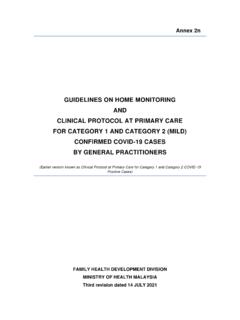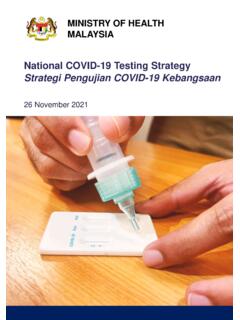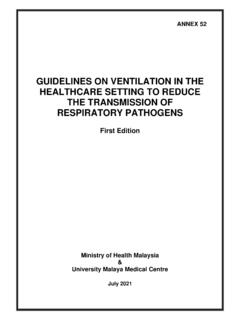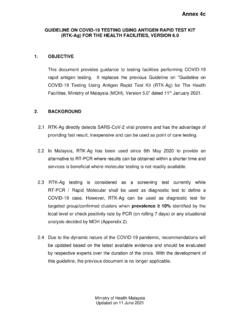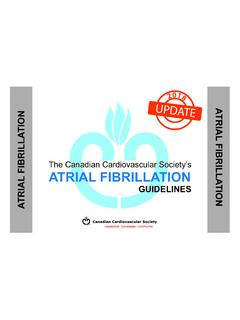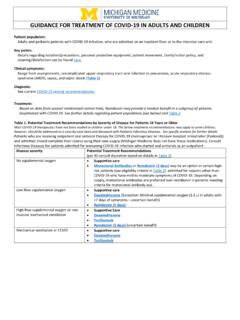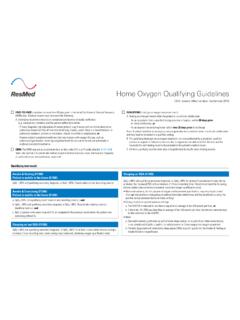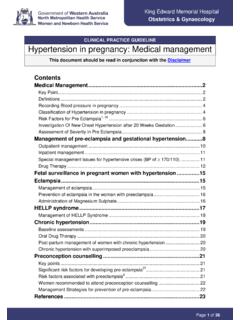Transcription of CLINICAL GUIDELINES ON COVID-19 VACCINATION FOR ...
1 1 Version July 2021 CLINICAL GUIDELINES ON COVID-19 VACCINATION FOR ADOLESCENTS (12-17 YEARS) IN MALAYSIA _____ Ministry of Health, Malaysia Version July 2021 2 Version July 2021 CLINICAL Guideline on COVID-19 VACCINATION for Adolescents (12 17 years) 1. Background This guideline is based on review of available published literature and international GUIDELINES on COVID-19 VACCINATION in adolescents age 12-17 years. At the time of writing, COVID-19 vaccine is not licensed for use in children below 12 years of age.
2 Therefore, to protect these young children, VACCINATION of all eligible household members, caregivers, teachers and other close contacts should be promoted. DISCLAIMER This statement is current as of 30th June 2021, and recommendations may change as more data become available. Please consult the treating clinicians before VACCINATION . For further update and information, please refer to the GUIDELINES for COVID-19 VACCINATION from MOH Malaysia. 2. RECOMMENDATIONS Adolescents with underlying medical conditions are at an increased risk for severe COVID-19 and should be prioritised to receive COVID-19 vaccine.
3 Adolescents with no underlying medical conditions are still at risk for severe COVID-19 , although the risk is lower. They may be offered COVID-19 VACCINATION . The timing of VACCINATION shall follow the national COVID-19 immunisation program schedule taking into consideration existing vaccine priorities in the country. At this time, Comirnaty (Pfizer-BioNTech) is the only approved COVID-19 vaccine in adolescents 12-17 years old. Two standard doses of the vaccine (30mcg) should be given at least 21 days apart. Prophylactic oral analgesics or antipyretics, such as paracetamol or ibuprofen, should not be routinely used before or at the time of VACCINATION , but may be considered for the management of pain or fever after VACCINATION .
4 3. Introduction Children and adolescents have, so far, been relatively spared from the full brunt of the COVID-19 pandemic. Data from large epidemiological studies worldwide showed they were infected less commonly than Most of the children and adolescents that were infected, had no or mild, self-limiting symptoms. However, some children and adolescents have severe disease and a few have died. Many of them have underlying chronic medical conditions that predispose them to severe illness and are more likely to develop complications arising from 3 Version July 2021 In addition, children and adolescents with COVID-19 are also at risk of developing a rare, but serious condition known as Multi System Inflammatory Syndrome in Children (MIS-C).
5 The CLINICAL features mimic those of Kawasaki Disease, Kawasaki Disease Shock Syndrome and Toxic Shock Syndrome. CLINICAL features include persistent fever, hypotension, gastrointestinal symptoms, rash, myocarditis, and laboratory findings associated with increased Epidemiological data from the earlier part of the COVID-19 pandemic showed that children and adolescents constituted on average less than 10% of the total number of cases. More recently, the proportion of children and adolescents reported to have COVID-19 has Similar trend is seen in Malaysia with recent data from CPRC showing children < 18 years comprised of of total cases, an increase from less than 10% at the end of Several factors possibly contributed to the increase including more testing being done in children, and more worryingly, the spread of new, more infective variants of the virus.
6 Children and adolescents also suffer significantly from the indirect impact of COVID-19 pandemic. The pandemic has tremendously disrupted family and social life, interrupted schooling and education as well as social development of the children and adolescents; the impact of which may not be fully reversed. 4. Priority Groups for COVID-19 VACCINATION Although the data is still limited, children with underlying medical conditions are at a greater risk for severe COVID-19 including hospitalisation, ICU admission and death. A wide spectrum of underlying medical conditions associated with severe COVID-19 have been reported in the published literature including chronic respiratory diseases, cardiovascular diseases, hypertension , immunosuppression, diabetes mellitus, chronic kidney diseases, neurological conditions and Due to the increase risk of severe COVID-19 , this category of children and adolescents should be prioritised to receive COVID-19 VACCINATION as soon as possible.
7 The list of underlying medical conditions with increased risk of severe COVID-19 is given in Table 1 below. The list is not exhaustive, and, CLINICAL judgement should be applied on risk-benefit of VACCINATION on case to case basis. Table 1 Priority Groups for COVID-19 VACCINATION in Children and Adolescents (12-17 years) Underlying medical conditions that increased the risk for severe COVID-19 (Conditions listed here are in no order of priority) 1 Immunocompromised due to disease or treatment* Bone marrow or stem cell transplant recipients. Solid organ transplant recipients.
8 Haematological malignancies. Cancer patients on active chemotherapy. Severe aplastic anaemia. 4 Version July 2021 Autoimmune or autoinflammatory disorders requiring long term immunosuppressive treatment. Receiving systemic steroids for > 1 month at a daily dose equivalent to prednisolone 20mg or more (for patient weighing < 10kg, prednisolone dose of > 2mg/kg/day for > 14 days). Receiving immunosuppressive or immune-modulating biological therapy such as anti-TNF, rituximab. 2 HIV Infection HIV infection at all stages. 3 Asplenia or dysfunction of the spleen Those who have undergone splenectomy and those with conditions that may lead to splenic dysfunction, such as thalassemia major and coeliac syndrome.
9 4 Chronic heart disease and vascular disease Congenital heart disease, cardiomyopathy, individuals with arrhythmia, chronic rheumatic heart disease with valve involvement, pulmonary hypertension and right heart failure, chronic heart failure, individuals with aortic root dilatation. 5 Chronic kidney disease Kidney transplantation, ESRD on haemodialysis and CAPD, chronic kidney disease stage 3 and 4. Glomerulonephritis lupus nephritis. Nephro-urological problems. 6 Chronic gastrointestinal/liver disease Cirrhosis, biliary atresia. Inflammatory bowel disease, malabsorption syndrome.
10 7 Chronic neurological disease Cerebral palsy, chronic neuromuscular disease, epilepsy, learning disabilities, autism spectrum disorder, chronic demyelinating disease, hereditary and degenerative disease of the nervous system or muscles, stroke; or neurological disability requiring assistance in activities of daily living. 8 Chronic respiratory disease Chronic lung disease ( BPD survivors, bronchiectasis, bronchiolitis obliterans, chronic aspiration pneumonia, cystic fibrosis and primary ciliary dyskinesia). Chronic restrictive lung disease ( neuromuscular disorders, syndromic with hypotonia, skeletal disorders, metabolic disorders like mucopolysaccharidosis).
